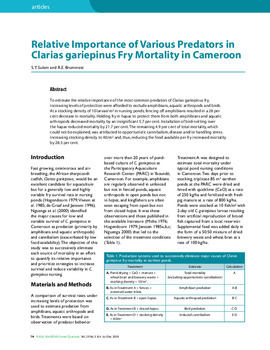Please use this identifier to cite or link to this item:
https://hdl.handle.net/20.500.12348/1839
Relative Importance of Various Predators in Clarias gariepinus Fry Mortality in Cameroon
| dc.creator | Sulem S.Y. | |
| dc.creator | Brummett, R.E. | |
| dc.date.accessioned | 2018-11-19T13:03:16Z | |
| dc.date.available | 2018-11-19T13:03:16Z | |
| dc.date.issued | 2006 | |
| dc.identifier.citation | NAGA, 29(3/4):74-77 | |
| dc.identifier.uri | https://hdl.handle.net/20.500.12348/1839 | |
| dc.description.abstract | To estimate the relative importance of the most common predators of Clarias gariepinus fry, increasing levels of protection were afforded to exclude amphibians, aquatic arthropods and birds. At a stocking density of 10 larvae/m² in nursing ponds, fencing off amphibians resulted in a 28 per cent decrease in mortality. Holding fry in hapas to protect them from both amphibians and aquatic arthropods decreased mortality by an insignificant 5.7 per cent. Installation of bird-netting over the hapas reduced mortality by 21.7 per cent. The remaining 4.9 per cent of total mortality, which could not be explained, was attributed to opportunistic cannibalism, disease and/or handling stress. Increasing stocking density to 40/m² and, thus, reducing the food available per fry increased mortality by 28.3 per cent. | |
| dc.format | application/pdf | |
| dc.language | En | |
| dc.publisher | WorldFish Center | |
| dc.rights | CC BY 4.0 | |
| dc.source | NAGA | |
| dc.title | Relative Importance of Various Predators in Clarias gariepinus Fry Mortality in Cameroon | |
| dc.type | Journal Article | |
| dcterms.bibliographicCitation | Sulem S.Y.; Brummett, R.E. (2006). Relative Importance of Various Predators in Clarias gariepinus Fry Mortality in Cameroon. NAGA, 29(3/4):74-77 | |
| cg.identifier.worldfish | 738 | |
| cg.subject.agrovoc | fish | |
| cg.subject.agrovoc | fish larvae | |
| cg.subject.worldfish | catfish | |
| cg.subject.worldfish | stocking | |
| cg.subject.worldfish | fry | |
| cg.contributor.affiliation | WorldFish | |
| cg.identifier.status | Open access | |
| cg.contribution.worldfishauthor | Brummett, R.E. | |
| cg.description.theme | Sustainable aquaculture |
Files in this item
This item appears in the following Collection(s)
-
Sustainable aquaculture [2735]
